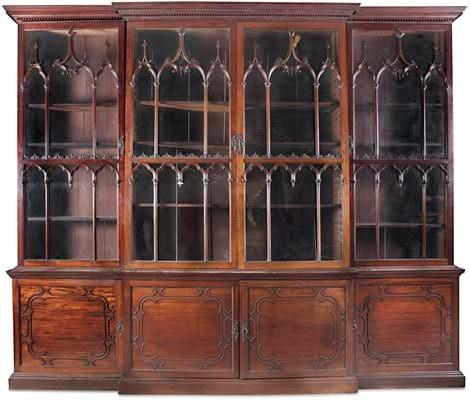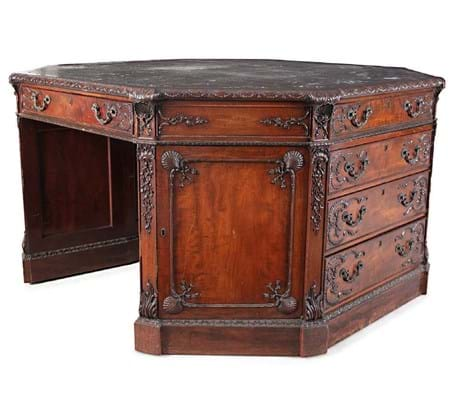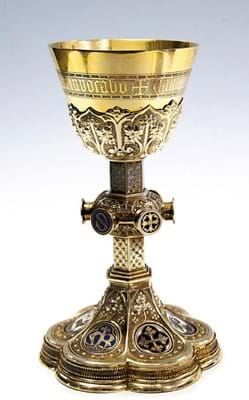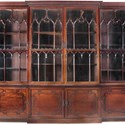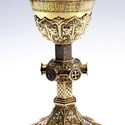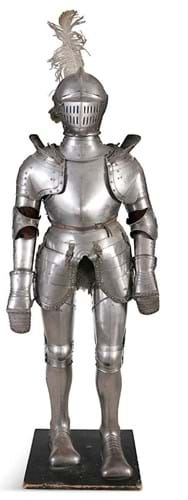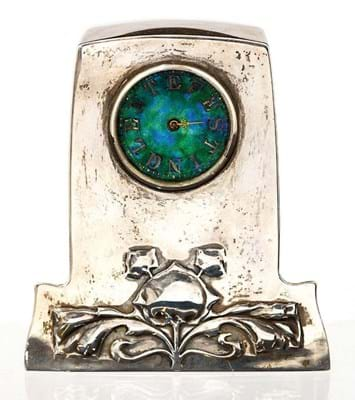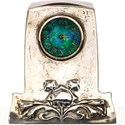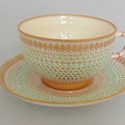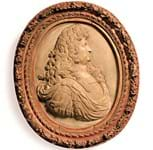The table itself had required a crane to move it from Bunratty Castle in the first place. So why do the country house setting?
“Because it works,” said O’Halloran. “It would have taken a series of sales at our Dublin rooms to achieve the €2.1m [premium-inclusive] total at Townley Hall.”
Partly this is down to space – the rooms overlooking St Stephen’s Green are elegant but not particularly spacious. However, there is also the enduring magic of a sale held in stately home surroundings. The auction took place on October 16.
“Everyone understands that the lots don’t come from the stately home itself,” said O’Halloran.
“But vendors want their pieces sold here and wouldn’t consign them to anything else. Buyers also love the idea. We had more than 600 people at the Townley Hall sale, many of whom we’d never see at Dublin.”
Auctioneer Adrian Rathbone faced a similar task when holding Hansons’ (20% buyer’s premium) six-day Autumn Fine Art sale at the 18th century Staffordshire mansion, Bishton Hall.
Day five of the October 10-15 sale did comprise 580 lots from the building which had been a prep school for 70 years school and 420 more were in the no-reserve attic sale. But most of the £1.1m hammer total was provided by the other 1830 lots consigned from other vendors and moved from Hansons’ base in Etwall, Derbyshire.
Celebrating an 86% success rate – and the firm’s first seven-figure series – Rathbone said: “Country house auctions are few and far between in these days of internet technology, but buyers still love the allure of taking a punt at select obj
“More than 600 people were at the first viewing day and sale days were just as busy and vibrant.”
Both of these concurrent sales included star items of such luminosity that they could have cast a shadow over everything else.
Adam’s beyond the Armada
As featured in ATG No 2364, Adam’s sold the €360,000 (£316,800) ‘Armada’ table, an important piece of documented Irish furniture pieced together using elements from a wrecked Spanish galleon, while Hansons had a £200,000 Tompion quarter repeating table clock.
But glittering as these prizes were – Hansons also sold a first edition of Adam Smith’s Wealth of Nations at £65,000 (also see Books and Works on Paper this edition) – there was room for others to shine. This was most notably so at Townley Hall where a dozen furniture lots took five-figure bids, contributing to the hammer total of €1.77m (£1.56m) from the 71% of the lots which got away.
As those figures suggest, it wasn’t all easy selling but there was plenty to celebrate. Leading the furniture was the Irish George III Chippendalepattern mahogany breakfront bookcase.
Standing 9ft 3in tall by 11ft 4in wide (2.82 x 3.46m), it was more sophisticated than most and was provenanced to a historic Dublin contents sale in 1910. Against an attractive €15,000-20,000 estimate, it sold to an Irish private buyer at €75,000 (£63,000).
A c.1750 mahogany side table with a scallop shell frieze was last seen at An Exhibition of Irish Furniture at the Irish Architectural Archive in Dublin in 2007.
It went to another Irish private buyer towards the top estimate at €37,500 (£33,000) while an ‘exceptional’ George II mahogany gate-leg double drop-leaf dining table, almost certainly from the same Dublin workshop as another sold for £62,000 at Christie’s Knight of Glin sale in 2009, went a shade below estimate at €29,000 (£25,520).
A George II Irish dining table doubled the mid-estimate. Notable for its 2in (5cm) thick mahogany top, the 10ft (3.05m) wide table on three pods on tripod bases had once been owned by the powerful Sligo landowner Charles O’Hara MP (1746-1822). By repute, O’Hara acquired it from the Irish Houses of Parliament following their dissolution in 1800 and it was consigned by a direct descendant. Against expectations of €10,000- 15,000, it sold to the Irish trade at €26,000 (£21,840).
American interest was evident in the sale and a US dealer went to a top-estimate €20,000 (£17,600) for a set of 18 Regency mahogany framed dining chairs by Dublin’s most successful early 19th century maker, Williams & Gibton.
One was signed in ink, MWG Mack, Williams & Gibton, 39 Staford Street, Dublin ‘Upholsterers & Cabinet Makers to his Majesty, His Excellency the Lord Lieutenant and His Majesty’s Board of Works’.
Among the UK trade’s purchases at a double-estimate €23,000 (£20,240) was an unusual Victorian octagonal mahogany partners’ desk that copied a celebrated design by William Vile (c.1700-67).
Measuring 4ft 8in (1.43m) wide and carved with an array of typical 18th century motifs, it had been retailed by Henry Samuel of Oxford Street (fl.1881-1913).
No Irish country seat was complete without a set of antlers of Megaloceros Giganteus, the giant Irish deer which roamed the country c.12,000-8000BC. An 11ft 5in (2.90m) wide set which had adorned the great hall of Dromoland Castle, source of the Armada Table, sold to an Irish-American private buyer at €47,000 (£41,360) just short of the top estimate.
Highlights among the silver included a suite of salvers, one measuring an impressive 23in (58cm) diameter and two smaller ones, by Joseph Jackson, Dublin, 1795. Each engraved with the armorial and motto of the Butler family, the suite went to an Irish collector comfortably above estimate at €10,500 (£9240).
Best of the horology was a Louis XV mantel clock in an ormolu and lapis lazuli case. Signed E Chenot A Paris, the 21in (54cm) tall clock surmounted with a crouching lion guarding a ball above a rectangular body doubled the mid-estimate in going to a UK dealer at £9500.
Another UK dealer took the top-selling piece of statuary: a white Carrera marble bust of the young Queen Victoria signed John Francis, who had been commissioned to sculpt a bust of Prince Albert in 1844.
Estimated at €4000-6000, it sold at €13,000 (£11,440).
Hansons’ chalice
Not forgetting a £19,000 result for a 1958 first series Land Rover, the top-seller from the country house auction at Hansons was a piece redolent of Bishton’s 70 years as a Catholic prep school: a Gothic Revival silver-gilt and enamel chalice and patten.
In the manner of William Burgess or AWN Pugin and marked JW Birmingham, the 1885, 8¼in (21cm) tall chalice and 1884, 4¾in (12cm) diameter patten sold to the London trade within estimate at £7000.
One of the main attractions in the wider sale selection was a late 19th century musical box stamped Nicole Frères, Genève.
Housed in a typical rosewood and marquetry case was a sophisticated 20-air Grand Format Piano Forte cylinder movement. It doubled the mid-estimate in selling at £9500.
Furniture had its highlights, with a c.1800 mahogany breakfront bookcase going at a quadrupleestimate at £4500 and a c.1765 mahogany serpentine-front chest of drawers with slide, fitted mirror and compartments to the top drawer which doubled hopes at £4800.
Knox clock
Among the horology, a couple of lesser eyecatchers emerged alongside the Tompion.
One was a Cymric silver-cased clock by Archibald Knox marked Liberty & Co, Birmingham, 1904. With a French movement, the 4in (10.5cm) tall clock with peacock enamelled dial missing a finger, was estimated at £2000-3000 and sold at £5200.
The other was a French desk clock in the form of a brass beam engine on a black slate plinth.
Dated c.1851 and with a mechanism by Guilmet, the 7½in (19cm) tall clock needed restoring and was pitched at £200-300. However, this breed of ‘industrial’ clocks attract dedicated collectors and this one sold at £3200.
There were no takers for two Daisy Makeig-Jones’s 1920s Fairyland lustre plaques pitched at £20,000- 25,000 each.
By contrast, a £1000-1500 estimate on a c.1887 Royal Worcester reticulated tea cup and saucer in the manner of George Owen attracted wide interest.
In very good condition with no restoration, it duly sold at £5000.
£1 = £1.19


